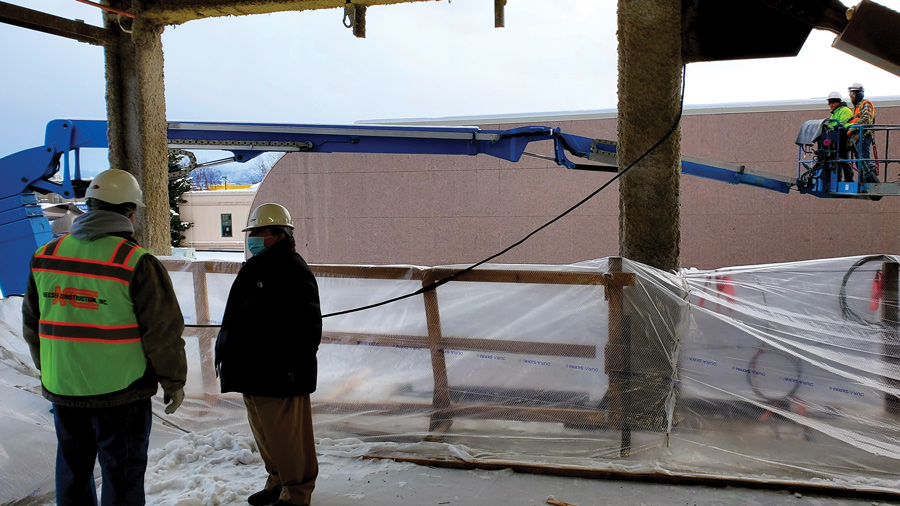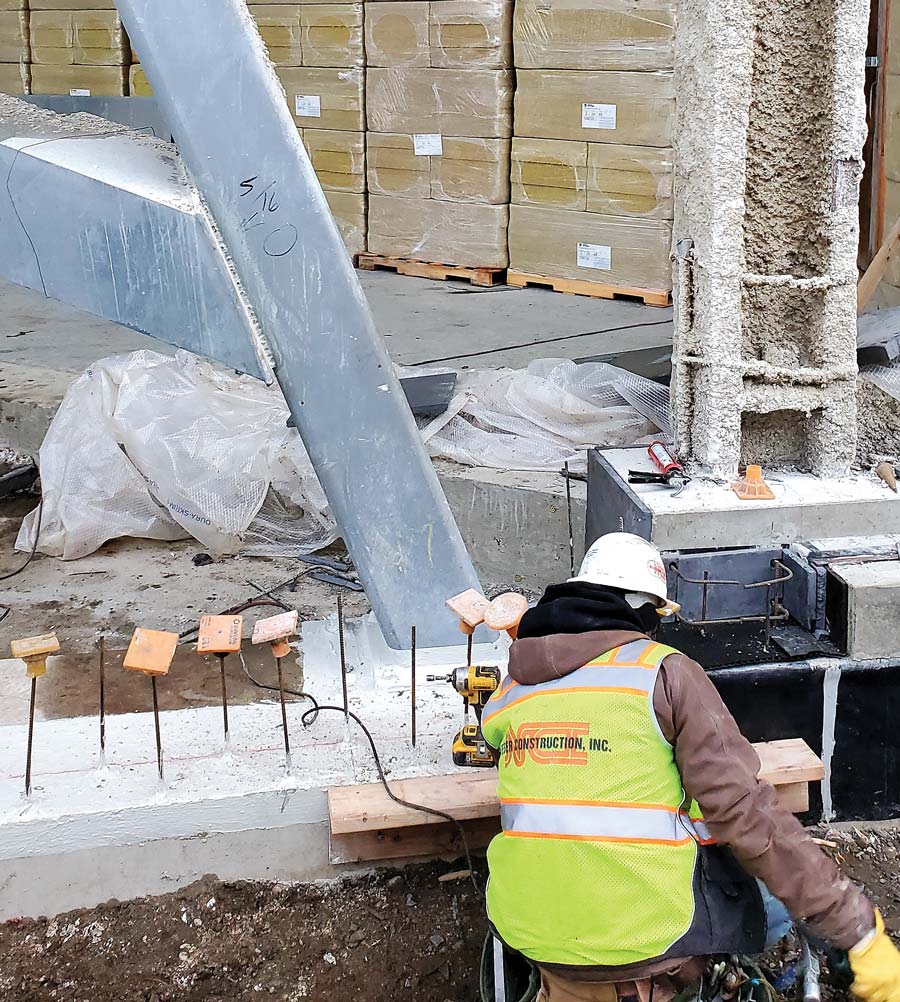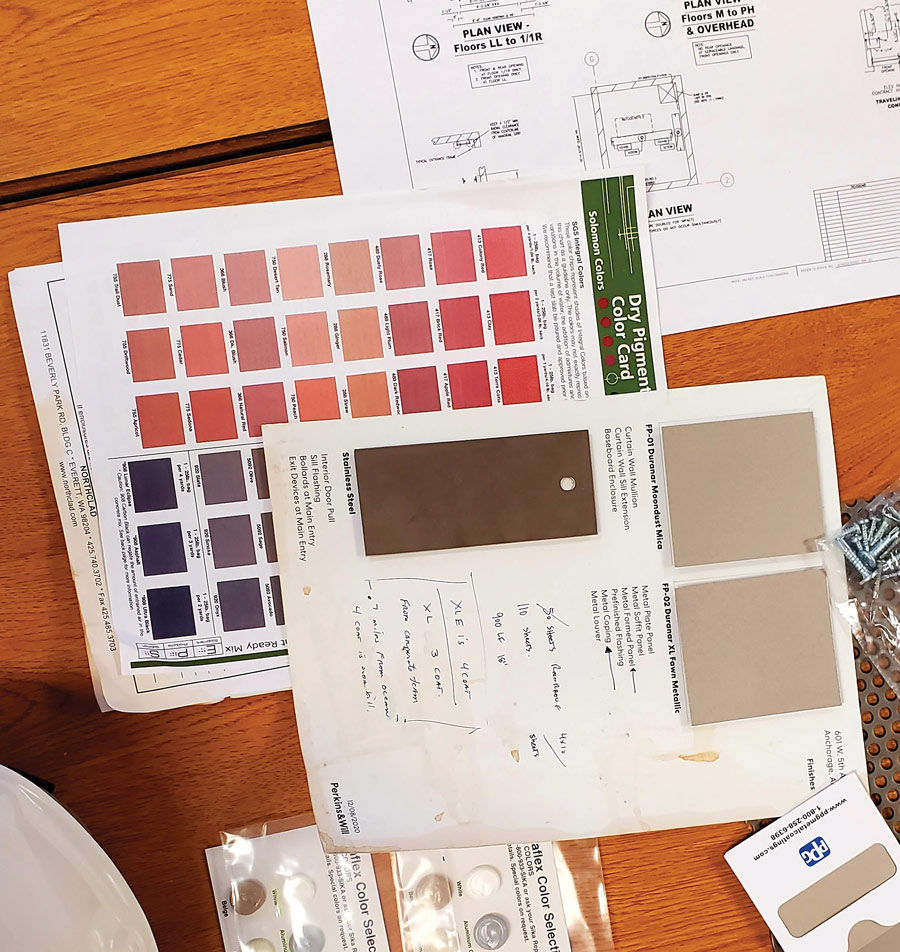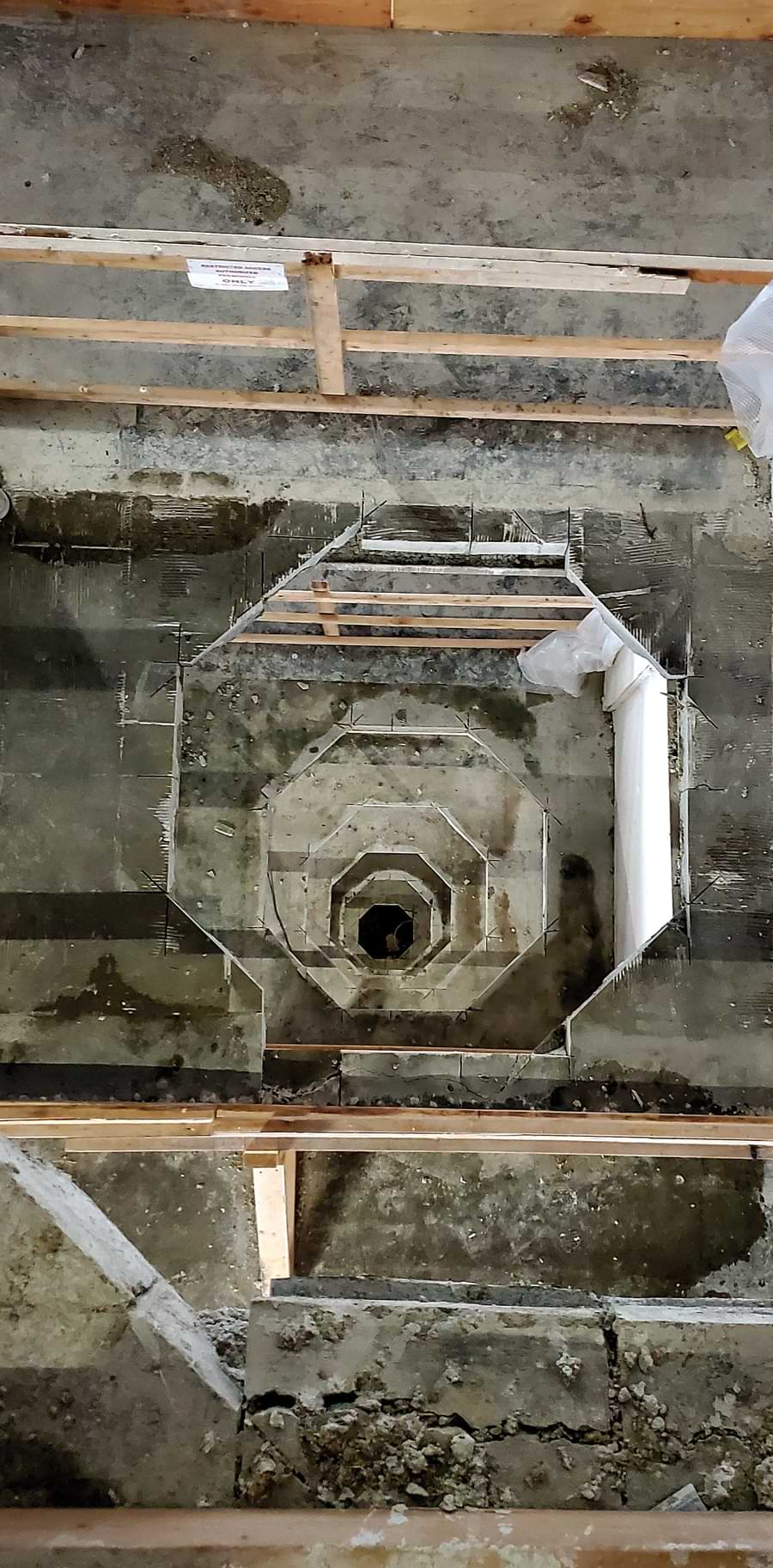he KeyBank Plaza in downtown Anchorage is no more. The magnitude 7.1 earthquake on November 30, 2018, killed it.
Oh, the nine-story building still stands at the corner of Fifth Avenue and F Street, but earthquake damage left it uninhabitable, so KeyBank has vacated as anchor tenant. Now the building is known by its address as 601 W. Fifth. Along with the new name, the building is getting a new look.
“The 601 building takes the precedent of the old structure and tries to retrofit it… inspired loosely by Alaska glaciers,” says Derrick Chang, general manager of 601 5th Avenue LLC. Based on that inspiration, the Seattle-based architecture firm Perkins&Will drew a design that strips the skin off the building, reinforces the skeleton, and puts a glazed covering on 33,000 square feet of new rentable space.
Slated for completion in summer 2022, the renovation resembles the shiny, oblique angles of 188 Northern Lights, also built and owned by Chang and his family through their development firm, Peach Investments. Whereas that ten-story office tower on top of a three-level parking garage cost about $40 million to build from scratch in 2008, the renovation of 601 W. Fifth has a price tag of at least $30 million, which pays for updated mechanical systems, floor-to-ceiling windows, and potential connections to the Egan Convention Center (more on that later).
However, Chang says unforeseen increases in the cost of freight, materials, and labor have driven the total closer to $35 million. In a way, tearing it all down might have been easier.
Brad Hinthorne, managing principal for Perkins&Will, describes the ‘70s vintage design as “precast concrete with strip windows, kind of a V shape, [and a] blank wall facing the parking lot.” Not very attractive for new tenants.
“We are trying to make this into an iconic signature class-A office building,” says Chang, “and I think the architecture, the shape, and also the orientation really speaks to that.” As the owner, Chang had to decide how much of the old building to keep and how much to scrap.
Hinthorne explains, “They look at the pros and cons of their asset and they say, ‘What if we left the skin the way it is and only did some repairs?’ and ‘What if we completely re-did it? If we re-did it, can we also add square footage? Or can we not?’… And also how does it compare to the cost of starting over, rebuilding new?”
The decision is based largely on the condition of the existing structure, but that analysis was complicated by a lack of detail. Mike Fierro, associate principal with Reid Middleton and the structural engineer of record on 601 W. Fifth, found only nine sheets of structural blueprints from the original construction, compared to forty-five sheets for the renovation. “When we’re going back and renovating those old buildings,” Fierro says, “it’s always difficult to figure out ‘Why did they do this?’ or ‘How would they do that?’”
The architect’s job is to walk the client through the options. Hinthorne says, “If you added it all up and looked at the price tag of doing all of those things, it’s less expensive than doing new and probably more valuable, at the end of the day, than just putting some Band-Aids on it.” Most clients would’ve done the bare minimum, Hinthorne believes, but Chang was convinced that a new skin on old bones would solve several problems at once for about the same cost.
“It’s a tough leap, right, to go from ‘Do we just renovate the building?’ to entirely new skin, new vision, new image, and a new presence,” Hinthorne says, adding, “Good for them.”
Alaska Business
Alaska Business

Alaska Business

Alaska Business
The renovation also allows for asbestos abatement, says Neil Bhargava, senior project manager for Neeser Construction. The general contractor started demolition in July 2020, chipping concrete panels off the steel columns. By November 2020, almost nothing was left but a framework of girders, slab floors, and the solid concrete wall on the west side that the entire structure ties into.
To be clear, plans for renovation predated the 2018 earthquake. Engineers from Reid Middleton had been sketching options for building add-ons since May of that year. “The engineer they were talking to at the time said they should probably tear it down and start over, which in hindsight isn’t a bad idea,” Fierro says with a laugh.
The initial analysis concluded that a seismic upgrade was not necessary but would be a good idea. After the quake, though, it became essential. “The north tower was damaged,” Fierro says. “I went out and said, ‘Yeah, this shouldn’t be opened to the public.’”
Where the concrete cracked, some temporary strengthening was added, but Fierro says a full upgrade would have been too expensive. Therefore, he came up with what he calls a “clever approach” that had been tried on a previous building: steel bracing that pulls the structural load away from the west wall.
Hinthorne says, “In this case it was the perfect storm of, you know, there was some seismic improvements that were needed… the ability to add more square footage, the ability to make it a more high-performing building.” And it all worked out for the best.

The most visible new feature is a ground-to-roof “prow” oriented southeast, overlooking Town Square Park and toward the Chugach Mountains. The geometry is dictated by Chang’s desire to expand the old floorplan. “It’s rather inefficient, in terms of layout,” he says. “The core is sitting on the middle of the ‘L,’ and you have the floor extending on the east side and the south side… we’ve tried to backfill the remaining space by approaching more of a square shape.”
The new addition fills in the middle of the “L,” increasing the floor area from 8,000 square feet at ground level to roughly 11,000 square feet per floor, Chang explains. Consequently, the upper floors cantilever over the plaza below.
Fierro never worked on a nine-story building before, but he was involved in the expansion of the Consortium Library at UAA, where the third floor extends beyond the foundation (and where multi-story windows reveal the structural crossbeams).
The building shape is also a new one for Kirk Malanchuk, the project architect for Perkins&Will. “Structurally, it has garnered its own amount of attention from the engineering community,” he says, “which I think is somewhat representative of the challenge of it.”
One huge challenge is that the foundation was not designed to hold a cantilever, like a diving board nine stories high. Thus, Neeser had to install a new foundation—with the building still on top of the old one.
“The underpinning we did,” Bhargava explains, “by drilling the holes in the concrete to support the existing footings, and then we dug the dirt below the concrete and then put the rebar and poured the concrete. So that was a tricky job.”
The beefed-up foundation takes the load from two angled columns that define the triangular face of the “prow.” But not directly—the design has an additional complication.
For a more inviting entrance from Fifth Avenue, the south leg of the “prow” splits just below the second floor, transferring its load to two smaller columns, both more horizontal than vertical. Indeed, one of them is not designed to hold any weight from above; Fierro says it’s only there for “wind girt” to resist lateral stresses.
The other, shorter angled column does hold weight—up to 1.2 million pounds, Fierro says—but it’s in a more precarious position, parallel to a busy street. “If something happened to that column—if a drunk driver was able to get there and impact it—it could’ve potentially caused some collapse to the addition,” Fierro says, explaining why he calls that crucial piece of steel “The Jenga Column.”
“So I designed the building with the column and without it,” Fierro says. “What I did was, I asked, begged, pleaded with the architects if I could put in something called belt trusses.”
Essentially, additional cross-braces around the second, third, and fourth floors create a box that can do the Jenga Column’s work, in a worst-case scenario. Fierro calls it “collapse prevention design.”
Alaska Business
Alaska Business

Alaska Business

Alaska Business
“The way this developed and the aesthetics of what they wanted it to look like—20/20 hindsight, it may have been easier [to tear down and build fresh],” Fierro says. “It may not have been less expensive, but it definitely would’ve been easier just to start over.”
The icy appearance relies on glass manufactured in Japan and assembled into panels in Thailand, but those materials got stuck in the international shipping slowdown. Until they arrived, Neeser kept the workflow going with plumbers installing bathrooms and fire sprinklers while exposed to the winter chill.
The glass is being installed from bottom to top, which presents a new problem. Chris “CJ” Hollwedel, site supervisor for Neeser Construction, says the building is about 30 or 40 feet taller than the company’s tallest man lift. Therefore, the curtain wall for the top floors is being hung from a swing stage suspended from a scaffold.
“Most of the time, once a client decides what they’re gonna do, you’re behind,” Hinthorne says, but he also credits Chang with having “very good taste and very good design sensibilities.”
Chang had worked with Perkins&Will on 188 Northern Lights, and he says he takes a very active role in the project.
The architects, too, remain hands-on. “The nature of architecture is that the drawings are there for one very important reason,” Malanchuk says, “but during construction we still need to be involved to see that vision through to the end, to work on the owner’s behalf to assist the contractor in getting there.”
Malanchuk visits Anchorage at least monthly, according to Bhargava. “Whatever our ideas, we have to tell them, and then always they accept our ideas because we know how to build it,” Bhargava says with a chuckle.
Hinthorne explains, “You design the lobby, and then you want the rest of the floors to be as flexible as possible to accommodate whoever: multi-tenant, single tenant, big tenant, small tenant. You want to keep the pool of potential tenants as big as you can.”
Whoever occupies the top floor must be a very special tenant. Not only is the floor area the widest (because of the cantilevered prow) but the ceiling is double height. Mechanical systems in the old penthouse have been relocated, allowing the ninth floor to rise to the full 20-foot height of the original roof.
The relocated mechanical systems include three new natural gas-fired boilers, a new air handling unit, and a rooftop exhaust fan. Because of the added interior volume, a larger air duct rises between the core elevators, wide enough for two or three John McClanes to shimmy through. The building also gets updated electrical circuits, switching gear, and LED lighting.
Every detail, from the shape and color of the wooden handrails on the stairs to the texture of the floor in the janitor’s closet, is dictated by the client’s and architect’s vision and executed by the builder. “Whenever we go and we look at the building, we feel proud of it, all the finishes and how our people did,” says Neeser’s Bhargava.
Outside, the grounds are the domain of civil engineers. Chmielowski says DOWL’s landscape architect worked closely with Chang, Perkins&Will, and the Parks & Recreation Department to design replacement plantings that the city can easily maintain. “The final product is a great example of the city and developers working together to have site features that not only enhance the building but also brings a new vision to this area in downtown Anchorage,” she says.
DOWL also was responsible for grading the new plaza and sidewalk, angled just enough to shed stormwater with no more than a 2 percent slope, to meet accessibility requirements. The outdoor surfaces—underneath the looming prow—are also heated by the building’s boiler, to melt snow, and the plaza has inlaid triangular skylights for the enlarged basement.
Alaska Business

Alaska Business
Alaska Business
Alaska Business

Chang envisions a possible opening to connect to the basement meeting rooms in the Egan Center. Another option is an enclosed bridge over F Street into the neighboring building, right next to the skyway across Fifth Avenue to the Performing Arts Center.
“Most winter cities have skybridges, if not underground connections,” Chang says, “so we have done our share of infrastructure to prepare for future connections.” Sure enough, the new cross-bracing leaves an opening at one corner of the east wall of the mezzanine. “We just want to make sure all that infrastructure is done ahead of time… so when we are ready to jumpstart the huge plan, that can be done without disturbing the tenants in the building,” he adds.
Putting a bridge over a city street is a political matter for another time. What’s certain is that 601 W. Fifth is, all by itself, a new landmark on one of Anchorage’s main avenues.
Anchorage Downtown Partnership (ADP) Executive Director Amanda Moser welcomes the renovation, saying, “The glacier-inspired facade is a delightful that tip to Alaska and our natural beauty while the upgrades and improvements bring the building and the feel of downtown into a more modern space.” Moser says ADP also anticipates further developments for Block 41, the city block that includes 601 W. Fifth at one end and the historic Fourth Avenue Theater at the other.
At one point, Peach Investments proposed a brand-new tower for the block, twenty-five stories high—easily the tallest building in Alaska. Chang says that project has been on the back burner for decades, but master planning continues for Block 41. “601 really jumpstarts this whole development,” he says. “We do see this being a pivot of the core.”
Will that mean more work in Alaska for Perkins&Will? Hinthorne says nothing is imminent, at least not on the scale of 601 W. Fifth. If Chang wants his firm to work on the next phases, though, he says he’s ready and willing. ![]()